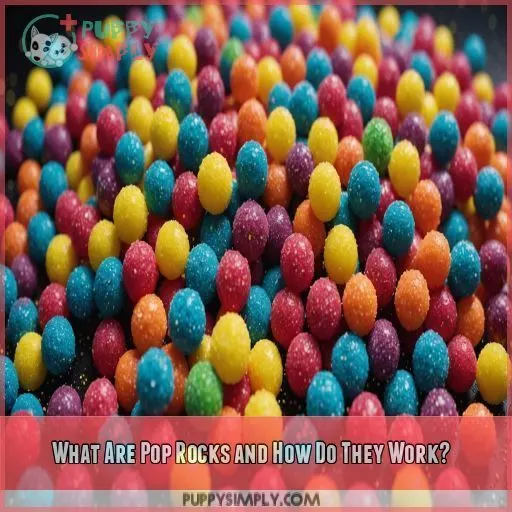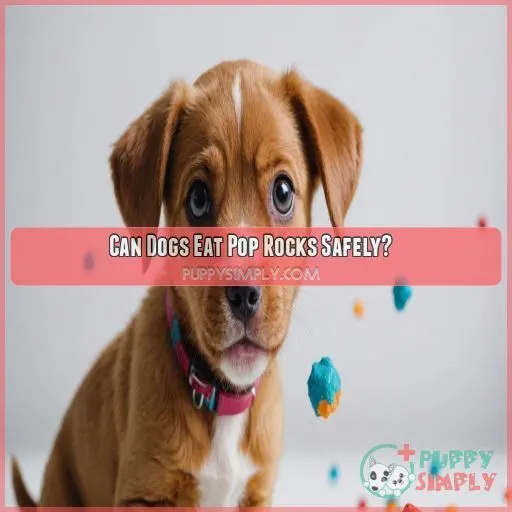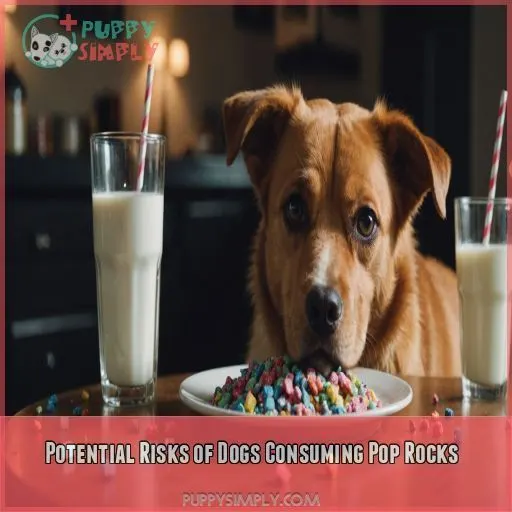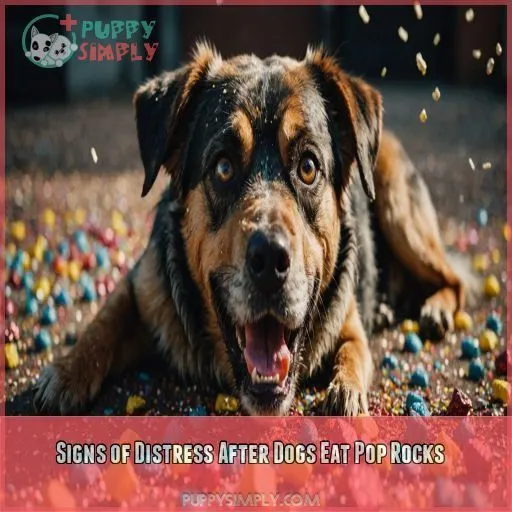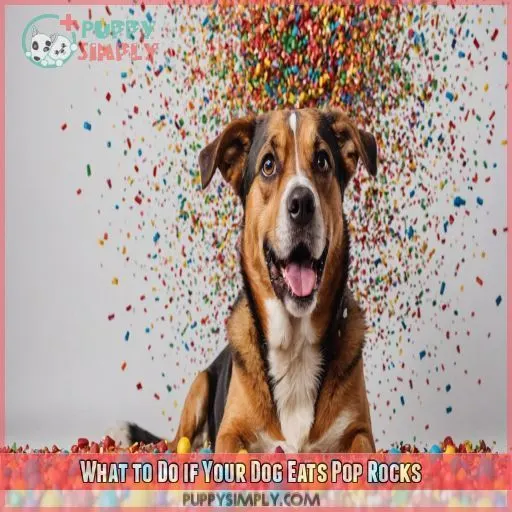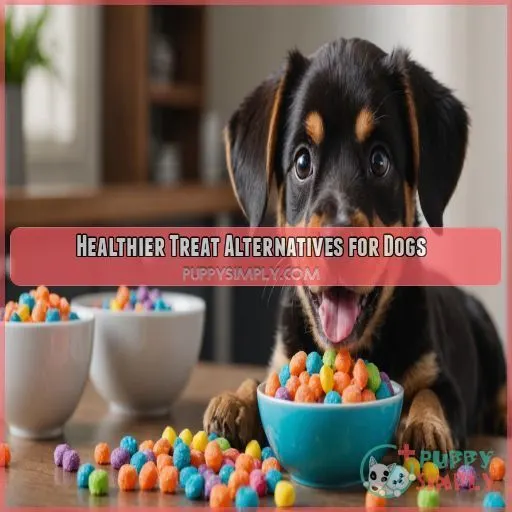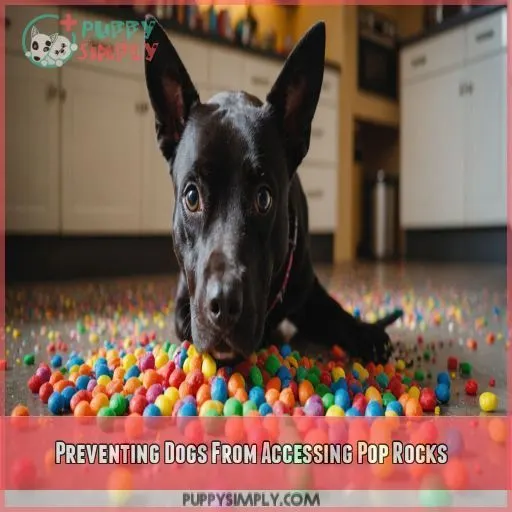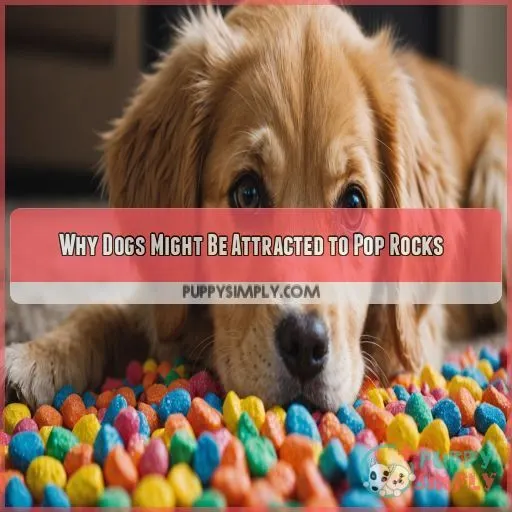This site is supported by our readers. We may earn a commission, at no cost to you, if you purchase through links.
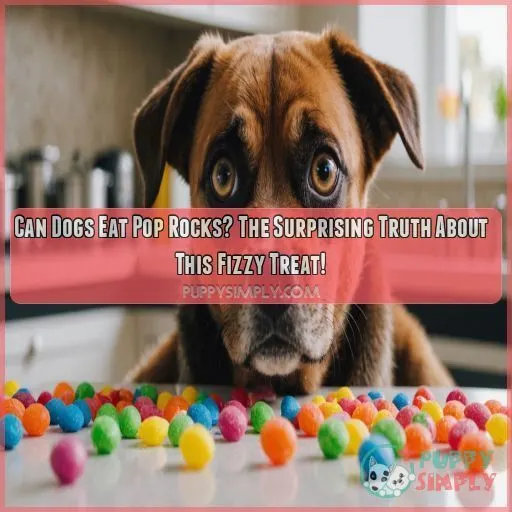
While a tiny amount might not be toxic, Pop Rocks are definitely not healthy for dogs. The high sugar content is bad news for canines, and the artificial colors and flavors can be harmful.
Additionally, you don’t want your pooch getting their paws on the packaging, which could lead to a dangerous intestinal blockage.
Table Of Contents
- Key Takeaways
- What Are Pop Rocks and How Do They Work?
- Can Dogs Eat Pop Rocks Safely?
- Potential Risks of Dogs Consuming Pop Rocks
- Signs of Distress After Dogs Eat Pop Rocks
- What to Do if Your Dog Eats Pop Rocks
- Healthier Treat Alternatives for Dogs
- Preventing Dogs From Accessing Pop Rocks
- Why Dogs Might Be Attracted to Pop Rocks
- Expert Opinions on Dogs and Human Candy
- Frequently Asked Questions (FAQs)
- Are Pop Rocks safe to eat?
- Can dogs eat candy rock?
- Is it safe for dogs to chew rocks?
- Why does my puppy like eating rocks?
- Are Pop Rocks toxic to dogs?
- What are the ingredients in Pop Rocks?
- How do I know if my dog ate Pop Rocks?
- Can I give my dog sugar-free candy instead?
- What should I do if my dog likes sweet foods?
- Conclusion
Key Takeaways
- Don’t even think about sharing your Pop Rocks with your furry friend – those fizzy treats are a recipe for disaster for dogs, packed with sugar, artificial colors, and a potential choking hazard.
- If your pup gets into Pop Rocks, keep a close eye on them for signs of distress, such as vomiting, diarrhea, or lethargy, and be prepared to call the vet if things take a turn for the worse.
- Instead of reaching for human candy, treat your dog to healthier alternatives, like carrots, green beans, or homemade dog treats made with natural ingredients – their tail (and tummy) will thank you!
- Keep those Pop Rocks and other human snacks out of paw’s reach by storing them in dog-proof containers and teaching your pup the "leave it" and "drop it" commands – it’s like giving them a superpower against temptation!
What Are Pop Rocks and How Do They Work?
You’ve probably seen Pop Rocks candy before, but do you know what makes them so unique? Let’s uncover the science behind these fizzy treats and explore their ingredients, how they work, and some popular flavors that might surprise you.
Ingredients in Pop Rocks
- Sugar (the main ingredient)
- Lactose (milk sugar)
- Artificial flavoring (for that fruity taste)
- Pressurized carbon dioxide (the secret fizz factor)
It’s like a miniature flavor explosion in your mouth! But for Fido? Not so much.
The Science Behind the Popping Sensation
Ever wondered what makes Pop Rocks pop? It’s not magic, it’s science! These tiny candies are packed with pressurized carbon dioxide bubbles. When they hit your tongue, the moisture dissolves the sugar coating, releasing the gas. This creates that fun fizzing sensation in your mouth. It’s like a mini fireworks show for your taste buds!
Popular Flavors and Varieties
You’ve probably seen Pop Rocks in classic flavors like strawberry and cherry, but did you know they come in wild varieties too? From cotton candy to tropical punch, there’s a fizzy explosion for every taste bud. Some brands even release limited edition flavors that’ll make your dog’s ears perk up – but remember, these treats are for humans only!
Can Dogs Eat Pop Rocks Safely?
Now that you know what Pop Rocks are, you’re probably wondering if they’re safe for your furry friend. The short answer? It’s best to keep these fizzy treats away from Fido. While a tiny amount mightn’t be catastrophic, it’s not worth the risk. Here’s why you should think twice before sharing:
- Pop Rocks are loaded with sugar
- They contain artificial colors and flavors
- The popping sensation could scare or confuse your pup
- There’s a potential choking hazard
Potential Risks of Dogs Consuming Pop Rocks
While Pop Rocks might seem like a fun treat to share with your furry friend, they can pose several risks to your dog’s health. Let’s explore why these fizzy candies aren’t the best choice for your canine companion and what potential problems they could cause.
Sugar Content and Canine Health
You might think a little sugar won’t hurt your furry friend, but it’s a slippery slope. Pop Rocks pack a sugary punch that can wreak havoc on your dog’s health. Check out this breakdown of sugar’s impact:
| Issue | Cause | Solution |
|---|---|---|
| Tooth decay | Sugar buildup | Regular dental care |
| Weight gain | Empty calories | Balanced diet |
| Diabetes risk | Blood sugar spikes | Limit treats |
| Upset tummy | Digestive stress | Stick to dog food |
Artificial Colors and Flavors
While Pop Rocks’ artificial colors and flavors might seem harmless, they can spell trouble for your furry friend. Some dogs may develop allergies or behavioral changes from these additives. It’s like giving your pup a chemical cocktail – definitely not on the menu!
Choking Hazards and Digestive Issues
- Potential choking hazard
- Risk of digestive upset
- Difficulty passing through intestines
Carbon Dioxide and Bloating Concerns
You might think Pop Rocks are just a fun treat, but for dogs, they’re a ticking time bomb of tummy troubles. The carbon dioxide that makes them pop can cause some serious bloating issues. Check out this quick rundown:
| Symptom | Risk Level | Action |
|---|---|---|
| Mild discomfort | Low | Monitor |
| Excessive gas | Medium | Call vet |
| Severe bloating | High | Emergency |
Signs of Distress After Dogs Eat Pop Rocks
If your furry friend has snuck a taste of Pop Rocks, you’ll want to know what signs of distress to look out for. Let’s explore the telltale symptoms that might indicate your pup isn’t feeling so great after their fizzy snack adventure.
Gastrointestinal Symptoms to Watch For
Keep a watchful eye on your furry friend’s tummy troubles! If your pup’s gotten into Pop Rocks, they might be in for a wild ride. Watch out for vomiting, diarrhea, or excessive gas – it’s like a doggy stomach rollercoaster! Bloating or loss of appetite are also red flags. These gastrointestinal symptoms could mean your pooch isn’t feeling too hot.
Behavioral Changes Indicating Discomfort
Keep your eyes peeled for these behavioral red flags after your pup snacks on Pop Rocks:
- Panting like they’ve just run a marathon
- Restlessness that’d put a caffeinated squirrel to shame
- Whining or hiding as if the vacuum monster’s on the loose
These signs might mean your furry friend’s feeling under the weather. Time for some extra TLC!
When to Contact Your Veterinarian
If your pup’s acting like a deflated balloon after munching on Pop Rocks, it’s time to call the vet. Watch for the usual suspects: vomiting, diarrhea, or lethargy. But if Fido’s having breathing problems, don’t wait rush to the animal ER! Remember, it’s better to be safe than sorry when it comes to your four-legged friend’s health.
What to Do if Your Dog Eats Pop Rocks
If your dog has managed to sneak a taste of Pop Rocks, don’t panic! While these fizzy candies aren’t ideal for canine consumption, knowing what steps to take can help make sure your furry friend stays safe and comfortable.
Immediate Actions to Take
If your pup’s snagged some Pop Rocks, don’t panic! First, check for any plastic packaging they might’ve gobbled up. Remove any remaining candy from their reach. Keep a close eye on them for signs of distress. If you’re worried, give your vet a ring. They might suggest inducing vomiting or other steps to keep your furry friend safe.
Monitoring Your Dog’s Condition
After your initial response, keep a watchful eye on Fido. Look for any changes in dog behavior, like a sudden case of the zoomies or couch potato syndrome. Monitor for tummy troubles – vomiting or diarrhea could signal a Pop Rocks revolt. Notice shifts in appetite or energy level too. Remember, you’re the Sherlock Holmes of Canine Health!
Seeking Professional Veterinary Advice
If your pup’s Pop Rocks adventure has you worried, don’t hesitate to call the vet. They’re your go-to for canine health concerns, from allergies to tummy troubles. While it mightn’t be an emergency, a quick chat can put your mind at ease. Remember, it’s always better to be safe than sorry when it comes to your furry friend’s well-being!
Healthier Treat Alternatives for Dogs
While Pop Rocks aren’t suitable for your furry friend, there are plenty of healthier alternatives that’ll make their tail wag. Let’s explore some tasty, dog-friendly treats that’ll keep your pup happy and healthy without the worry of fizzy surprises.
Dog-Specific Treats and Their Benefits
You’ve got options beyond Pop Rocks, folks! Dog-specific treats are made just for your pup’s needs, packing a punch of nutrition without the sugar crash. They come in all shapes and sizes, from dental chews to training tidbits. Plus, these goodies often support joint health, shine up coats, and keep tails wagging. Win-win!
Homemade Treat Ideas for Dogs
Want to treat your furry friend without breaking the bank or compromising their health? Whip up some homemade dog treats! It’s easier than you think and a great way to show your pup some love. Here are five mouthwatering ideas that’ll have your dog’s tail wagging:
- Peanut butter and pumpkin biscuits
- Frozen yogurt paw prints
- Sweet potato chews
- Chicken and rice balls
- Carrot and oat cookies
Natural Fruits and Vegetables Safe for Dogs
Looking for healthier alternatives to Pop Rocks for your furry friend? Nature’s got you covered! Check out these dog-friendly fruits and veggies that’ll make your pup’s tail wag:
| Safe Snacks | Dangerous Treats |
|---|---|
| Apples | Grapes |
| Carrots | Onions |
| Blueberries | Garlic |
| Cucumber | Avocado |
| Pumpkin | Raisins |
Preventing Dogs From Accessing Pop Rocks
You’ve learned why Pop Rocks aren’t safe for dogs, but how can you keep your curious canine from getting into these fizzy treats? Let’s explore some practical strategies to protect your pup from Pop Rocks and other human snacks that could spell trouble.
Proper Storage of Human Snacks
Keep your Pop Rocks and other human snacks out of paw’s reach! Invest in dog-proof containers and store them in high cabinets. Organize your kitchen with safety in mind – think of it as puppy-proofing for grown dogs. Remember, your furry friend’s nose is like a snack-seeking superpower, so stay one step ahead!
Teaching Leave It and Drop It Commands
Teaching your pup "Leave it" and "Drop it" is like giving them a superpower against temptation! These commands can save your furry friend from Pop Rocks mishaps. Here’s how to make it fun:
- Use positive reinforcement
- Start with low-value items
- Gradually increase difficulty
Creating a Dog-Safe Environment at Home
Beyond teaching commands, creating a dog-safe environment is really important. Think of it as child-proofing for your furry friend. Here’s a quick guide to keep your pup safe:
| Area | Dog-Proofing Tips |
|---|---|
| Kitchen | Secure trash, store food |
| Living Room | Remove toxic plants |
| Bathroom | Lock cabinets, hide meds |
| Outdoor | Check fence, use safe products |
Why Dogs Might Be Attracted to Pop Rocks
Ever wonder why your furry friend seems oddly fascinated by Pop Rocks? It’s not just their love for human food – there are some surprising reasons dogs might be drawn to these fizzy candies. Let’s explore what makes Pop Rocks so intriguing to our canine companions and why it’s important to keep them out of paw’s reach.
Curiosity and Novelty Factors
Your curious canine might be drawn to Pop Rocks like a moth to a flame. Dogs are natural explorers, always sniffing out new experiences. The crackling sound and unusual texture of these fizzy candies can pique their interest. It’s like they’ve stumbled upon a tiny, edible fireworks show – irresistible to their adventurous spirit!
Smell and Texture Appeal
Beyond curiosity, your furry friend’s keen senses play a big role in their attraction to Pop Rocks. Dogs’ powerful noses can pick up on the candy’s sweet scent, while the unique texture might intrigue their taste buds. Here’s why Pop Rocks might catch your pup’s attention:
- Sugary aroma that’s hard to resist
- Interesting crackly texture
- Novel sensory experience
Attention-Seeking Behavior
Let’s face it, your furry friend might be eyeing those Pop Rocks for more than just their taste. Dogs are clever attention-seekers, and they know that grabbing forbidden treats often gets them noticed. It’s like they’re saying, "Hey, look at me!" This behavior could stem from boredom or even separation anxiety. Time for some positive reinforcement training!
Expert Opinions on Dogs and Human Candy
You might think Pop Rocks are just a harmless, fun treat, but what do the experts say about dogs eating human candy? Let’s hear from veterinarians, nutritionists, and animal behaviorists on whether these fizzy sweets are safe for your furry friend.
Veterinary Perspectives on Pop Rocks
Curious about what the pros think? Let’s chew on some veterinary wisdom about Pop Rocks and pups. Vets aren’t exactly wagging their tails over this fizzy treat. Here’s what they’re barking about:
- Sugar overload can lead to a ruff time
- Artificial ingredients might upset your furry friend’s tummy
- The popping sensation could startle or confuse dogs
Nutritionist Insights on Canine Diets
While vets caution against Pop Rocks, dog nutritionists emphasize balanced diets. They recommend:
| Nutrient | Commercial Food | Homemade |
|---|---|---|
| Protein | 18-25% | Lean meats |
| Carbohydrates | 30-70% | Brown rice |
| Fat | 10-15% | Fish oil |
| Vitamins | Fortified | Vegetables |
| Minerals | Balanced | Bone meal |
Animal Behaviorist Views on Treat-Giving
Animal behaviorists emphasize the importance of treat-giving as a powerful training tool. They recommend using positive reinforcement and varying your dog’s rewards. Timing is key – reward immediately after good behavior. But don’t go overboard! Portion control is essential. Remember, treats should make up no more than 10% of your pup’s daily calorie intake.
Frequently Asked Questions (FAQs)
Are Pop Rocks safe to eat?
You’re wondering if Pop Rocks are safe to eat? Well, for humans, they’re generally fine in moderation, but be cautious – those sugary treats can be detrimental to your dental health and diet if overconsumed!
Can dogs eat candy rock?
Sorry, no candy rocks for your furry friend! While an occasional sweet treat might seem harmless, candy rocks, like Pop Rocks, are high in sugar and can lead to health issues in dogs, so it’s best to keep them out of paw’s reach.
Is it safe for dogs to chew rocks?
Rocks are a recipe for disaster for your furry friend. Chewing on them can lead to dental damage, obstruction, or even intestinal blockages. Keep those paws away from pebbles, and opt for pup-safe toys instead.
Why does my puppy like eating rocks?
Your puppy’s fondness for eating rocks might be due to curiosity, boredom, or even a medical issue. Consult with your vet to rule out any underlying health problems and provide a safe, rock-free environment for your furry friend.
Are Pop Rocks toxic to dogs?
Oh no, your furry friend’s got a taste for the fizzy stuff! Don’t worry, Pop Rocks aren’t toxic to dogs, but they’re still a recipe for disaster – high in sugar and potentially scary for your pup!
What are the ingredients in Pop Rocks?
You’re curious about Pop Rocks‘ ingredients! Well, they’re made of sugar, lactose, and flavoring, with a fun fizzing effect from embedded pressurized carbon dioxide. That’s the secret behind their signature popping sensation!
How do I know if my dog ate Pop Rocks?
Did your furry friend get into something they shouldn’t have? If you suspect your dog ate Pop Rocks, check for signs like vomiting, diarrhea, or lethargy, and inspect their mouth and paws for any remaining popping candy.
Can I give my dog sugar-free candy instead?
Sorry to burst your bubble, but sugar-free candy isn’t a great alternative for your furry friend either. Many sugar-free treats contain xylitol, which can be toxic to dogs. Always prioritize dog-safe treats to keep them happy and healthy!
What should I do if my dog likes sweet foods?
If your dog has a sweet tooth, consider healthier alternatives like carrots or green beans. You can also try making homemade dog treats using natural ingredients. Just remember, always consult with your vet for personalized advice!
Conclusion
You’re enjoying your Pop Rocks, and you think about sharing them with your furry friend.
But hold on!
The answer is a resounding no.
Pop Rocks are a recipe for disaster for dogs.
They’re packed with sugar, artificial colors, and can be a choking hazard.
Keep those fizzy treats all to yourself.
Your dog’s tail (and tummy) will thank you!

